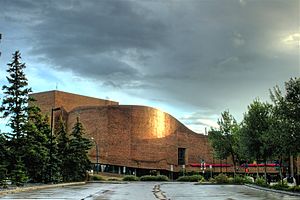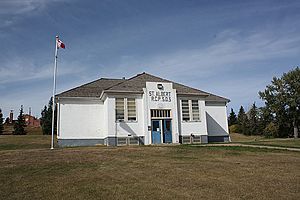St. Albert, Alberta facts for kids
Quick facts for kids
St. Albert
|
|||
|---|---|---|---|
|
City
|
|||
| City of St. Albert | |||
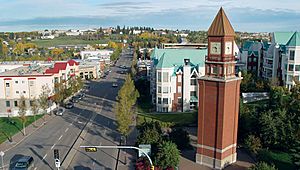
View of Downtown St. Albert
|
|||
|
|||
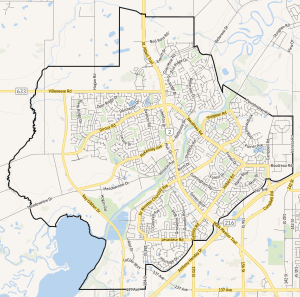
City boundaries
|
|||
| Country | Canada | ||
| Province | Alberta | ||
| Region | Edmonton Metropolitan Region | ||
| Adjacent municipal district | Sturgeon County | ||
| Founded | 1861 | ||
| Incorporated | |||
| • Village | December 7, 1899 | ||
| • Town | September 1, 1904 | ||
| • New town | January 1, 1957 | ||
| • Town | July 3, 1962 | ||
| • City | January 1, 1977 | ||
| Area
(2021)
|
|||
| • Land | 47.84 km2 (18.47 sq mi) | ||
| Elevation | 689 m (2,260 ft) | ||
| Population
(2021)
|
|||
| • Total | 68,232 | ||
| • Density | 1,426.4/km2 (3,694/sq mi) | ||
| • Municipal census (2018) | 66,082 | ||
| • Estimate (2020) | 69,335 | ||
| Time zone | UTC−7 (MST) | ||
| • Summer (DST) | UTC−6 (MDT) | ||
| Forward sortation area |
T8N
|
||
| Area code(s) | 780, 587, 825, 368 | ||
| Highways |
|
||
| Waterways | Sturgeon River, Big Lake | ||
St. Albert is a city in Alberta, Canada. It is located next to the Sturgeon River, just northwest of Edmonton, the capital city of Alberta. St. Albert started as a Métis community and is now the second-largest city in the Edmonton Metropolitan Region.
St. Albert became a town in 1904. The Canadian Northern Railway reached it in 1906. For many years, St. Albert was separated from Edmonton by farmland. However, in the 1980s, Edmonton grew. Now, St. Albert is right next to the larger city on its south and east sides.
Contents
History of St. Albert
St. Albert was founded in 1861 by Father Albert Lacombe. He was a missionary who built a small chapel in the Sturgeon River valley. This chapel, called the Father Lacombe Chapel, is still standing today on Mission Hill. The settlement was named Saint Albert after Father Lacombe's patron saint.
Father Lacombe first wanted to build the mission at Lac Ste. Anne. But the soil there was not good for farming. So, he moved the settlement to where St. Albert is now. This new spot was great because it had easy access to wood and water. The soil was also excellent for farming. It was a common stopping point for First Nations people. Plus, it was close to Fort Edmonton, where priests could buy supplies.
A few years later, a group of Grey Nuns joined Father Lacombe. More Métis people arrived in 1863. By 1864, about 300 people lived there. In 1870, a smallpox outbreak affected the area. It sadly caused the deaths of 320 out of 900 residents.
Residential Schools and Healing
St. Albert was once home to two Indian residential schools. These schools were part of a system that separated Indigenous children from their families. The St. Albert Indian Residential School operated from 1873 to 1948. The Edmonton Indian Residential School operated from 1924 to 1968.
To help with healing and understanding, a special garden was opened in St. Albert. It is called Kâkesimokamik, which means "healing garden." It opened on September 15, 2017. This garden is a place for truth and reconciliation between the city and those affected by the residential school system.
Correcting History
For many years, people mistakenly thought St. Albert was named after St. Albert the Great. This was due to incorrect information in a local history book. The city even put up a statue of the wrong saint! However, this mistake was corrected in 2008.
The original chapel built by Father Lacombe is now a historic site. You can visit it during the summer. Historical guides are there to tell you about its past.
Historic Sites in St. Albert
St. Albert has the St. Albert Grain Elevator Park. It features two old grain elevators. One was built in 1906, and the other in 1929. There is also a copy of the old 1909 railway station.
Another historic building is the Little White School House on Madonna Drive. It is also open to the public. The organization Arts and Heritage – St. Albert takes care of these sites. They also work on restoring other historic buildings in the city. There are plans to restore the grain elevators and open Métis and French Canadian farms nearby.
Economy and Jobs
St. Albert has many skilled workers. The unemployment rate is low, at 4.3%. This means most people who want jobs can find them.
Many adults in St. Albert have gone to college or university. In 2011, about 67.5% of adults aged 25 and over had completed some form of higher education. This is higher than the national average of 59.6%.
About 31.7% of adults have a university degree. Another 24.3% have a college diploma. And 11.6% have a trades certificate. This shows that St. Albert has a well-educated workforce.
Population and People
St. Albert has grown quite a bit over the years. In 2021, the city's population was 68,232 people. This was a small increase from 65,589 people in 2016.
Diversity in St. Albert
St. Albert is home to people from many different backgrounds. In 2021, most residents (83.4%) were of European background. About 11.1% were visible minorities, and 5.5% were Indigenous.
The largest groups of visible minorities included people from the Philippines (3.1%), South Asia (1.7%), and Africa (1.5%). There were also people from China (1.3%) and the Middle East (1.0%).
Languages Spoken
Most people in St. Albert speak English as their first language. In 2021, about 86.0% of residents spoke English as their mother tongue.
Other common first languages include French (2.6%) and Tagalog (1.5%). You might also hear German, Spanish, Ukrainian, Chinese languages, and Arabic spoken in the city.
Beliefs and Religions
According to the 2021 census, about 55.4% of St. Albert residents identify as Christian. The largest Christian group is Catholic, making up 27.9% of the population.
A growing number of people in St. Albert do not identify with any religion. In 2021, 41.3% of residents said they were non-religious or secular. Other religions like Islam (1.6%) and Hinduism (0.4%) are also present in the city.
Arts and Culture in St. Albert
St. Albert has a lively arts scene. Many community events happen at St. Albert Place, a building designed by famous Canadian architect Douglas Cardinal. This building has no sharp corners, only curves, like the Sturgeon River nearby.
St. Albert Place opened in 1984. It is a "people place" that combines city government offices with cultural activities. Inside, you'll find the St. Albert Public Library, the Musée Héritage Museum, a Visual Arts Studio, and the Arden Theatre.
Musée Héritage Museum
The Musée Héritage Museum tells the story of St. Albert. It has permanent and temporary exhibits. There's also a Children's Discovery Room and a gift shop. The museum keeps many historical items, photos, and records. It is managed by Arts and Heritage St. Albert.
Art and Performance
St. Albert is home to groups like a writers' guild and a painters' guild. Famous bands like Social Code and Tupelo Honey are from St. Albert. The Arden Theatre is a popular spot for plays and music shows.
The Art Gallery of St. Albert is in a historic building downtown. It hosts monthly art shows and public programs. It's also part of the St. Albert ArtWalk.
Honoring Heritage
St. Albert is proud of its Aboriginal heritage. The Michif Institute works to preserve and share knowledge about the city's Métis background. The Musée Héritage Museum has many Métis artifacts.
Many street signs in downtown St. Albert are trilingual. They are written in English, French, and Cree. This honors the city's diverse beginnings. The city plans to replace old English-only signs with these trilingual versions.
In 2008, parts of the TV series Fear Itself were filmed in St. Albert's downtown and river valley.
St. Albert also has a Children's Theatre group. They put on two big musicals each year and offer summer camps. The St. Albert Community Band also performs, with their motto "Music is for Life!"
Festivals and Events
St. Albert hosts many fun events throughout the year.
- Kinsmen Rainmaker Rodeo: This event starts with a parade through the city. After the parade, there are rodeo events, a midway with rides, and live music.
- Outdoor Farmers' Market: This is Western Canada's largest outdoor farmers' market. It happens every Saturday from June to October. You can find fresh local produce, handmade crafts, and listen to street musicians. It attracts 10,000 to 15,000 people each week!
- Rock'n August: This five-day festival celebrates classic cars and rock and roll music. Up to 6,000 people come to enjoy the rumble of engines and the sounds of classic rock.
- Other Events: Other annual events include the St. Albert Rotary Music Festival and the Harvest Festival at the Grain Elevator Park. The Cheremosh Ukrainian Dance Festival is also held here. It's one of the biggest dance festivals of its kind in North America.
Library Services
The St. Albert Public Library (SAPL) is located in St. Albert Place. It offers many services for residents and visitors. You can borrow books, CDs, and DVDs. They also have digital resources like eBooks and audiobooks. The library provides public computers and Wi-Fi. They also offer learning programs like story times for children, adult programs, and technology training.
Sports and Recreation
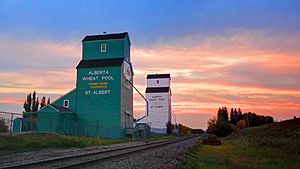
St. Albert is a great place for sports and outdoor activities.
Parks and Trails
The city has over 100 parks and playgrounds. The Red Willow park trail system winds through St. Albert. It connects many parks, schools, and neighborhoods, including Lacombe Lake Park.
Sports Facilities
In 2006, the city opened Servus Credit Union Place. This large $42.77-million leisure center has many features:
- A recreational aquatic center with a kids' play area.
- The Troy Murray, Mark Messier, and Go Auto Arenas for hockey.
- Two indoor fields for soccer and lacrosse.
- Three basketball courts.
- A large exercise room and a running track.
The Servus Credit Union Place expanded the original Campbell Twin Arenas. These arenas were built in 1992 and named after local National Hockey League (NHL) players Troy Murray and Mark Messier.
There are also two older ice hockey arenas, the Kinex and Akinsdale arenas, opened in 1982. In 2019, the Akinsdale Arena was renamed after retired NHL star Jarome Iginla. He played his minor hockey in St. Albert.
Other facilities include Fountain Park pool and Grosvenor pool. They offer various pools, tennis courts, and racketball courts.
Hockey in St. Albert
St. Albert has a strong hockey history. It was home to two Alberta Junior Hockey League (AJHL) teams. The St. Albert Saints played here from 1977 to 2004. Famous players like Mark Messier and Mike Comrie played for the Saints. The St. Albert Steel also played here from 2007 to 2012.
Many NHL players have played hockey in St. Albert, including:
- Jarome Iginla
- Rob Brown
- Geoff Sanderson
- Fernando Pisani
- Dion Phaneuf
- Colton Parayko
- Tyson Jost
Other Sports
- Football: St. Albert has an artificial turf field at Riel Park for all minor football teams.
- Cross Country Skiing: You can enjoy cross-country skiing along the Sturgeon River and at River Lot 56 Natural Area – Stanski. This area has groomed trails and maps.
- Soccer: The SASA Impact FC, run by the St. Albert Soccer Association, has a professional-amateur women's team.
Education in St. Albert
St. Albert offers excellent education options for students of all ages.
Schools for Kids (K-12)
There are two main school districts in St. Albert:
- St. Albert Public Schools: This district serves over 6,000 students. High school students attend Bellerose Composite High School or Paul Kane High School.
- Greater St. Albert Catholic Schools: This district operates 17 schools and serves about 7,600 students. High school students attend ESSMY or St. Albert Catholic High School.
St. Albert also has two schools from the North Central Francophone School Board. These schools, "École La Mission" (for younger students) and "École Alexandre-Taché" (for older students), offer education in French.
Learning for Adults
St. Albert Further Education, also known as "Further Ed," provides learning opportunities for adults. The STAR Literacy Program helps adults improve their reading and writing skills by matching them with volunteer tutors.
Media and News
St. Albert has its own local newspapers and magazines.
Print Publications
Currently, two publications are printed in St. Albert:
- The St. Albert Gazette: A newspaper published every two weeks.
- T8N: A monthly magazine that covers topics about the city and its people.
The first newspaper in St. Albert was a French paper called Le Progrès, started in 1909. Later, the bilingual St. Albert Star offered issues in both English and French.
The current St. Albert Gazette started in 1961. Over the years, other newspapers like the Saint City News and the St. Albert Leader have also been published, but they are no longer in print.
Radio Stations
St. Albert had its first radio station in 1978, called CKST Radio. It later became CFMG and then EZ Rock. In 2011, the station moved to Edmonton and changed its name to 104.9 Virgin Radio.
Because St. Albert is so close to Edmonton, residents can also access all major Edmonton newspapers, TV, and radio stations.
Getting Around St. Albert
Air Travel
The main airport for passenger flights is the Edmonton International Airport. For local air services, there's the St. Albert Heliport and Villeneuve Airport. The Sturgeon Community Hospital also has a helipad for patient transfers.
Public Transportation
The city has its own public transport system called St. Albert Transit (StAT). It runs 21 local bus routes and 7 routes that go to Edmonton. There are two main transit stations: Village Transit Station and St. Albert Exchange. There are also plans to extend Edmonton's Metro Line train to St. Albert, which would add four train stations within the city.
Famous People from St. Albert
Many talented people have come from St. Albert, including:
- Hercules Ayala: A professional wrestler.
- Hailey Benedict: A country music singer-songwriter.
- Rob Brown: An NHL ice hockey player.
- Kirby Dach: An NHL ice hockey player.
- Daryl Harr: A racing driver.
- Nick Holden: An NHL ice hockey player.
- Don Iveson: A former Mayor of Edmonton.
- Jarome Iginla: An NHL ice hockey player and Olympic medalist.
- Tyson Jost: An NHL ice hockey player.
- Marc Kennedy: A curler and Olympic medalist.
- Mark Messier: An NHL ice hockey player and six-time Stanley Cup champion.
- Meaghan Mikkelson: A professional women's ice hockey player and Olympic medalist.
- Colton Parayko: An NHL ice hockey player and Stanley Cup champion.
- Jason Thompson: An actor and model.
- Josh Mahura: An NHL ice hockey player and Stanley Cup champion.
See also
 In Spanish: Saint Albert para niños
In Spanish: Saint Albert para niños







